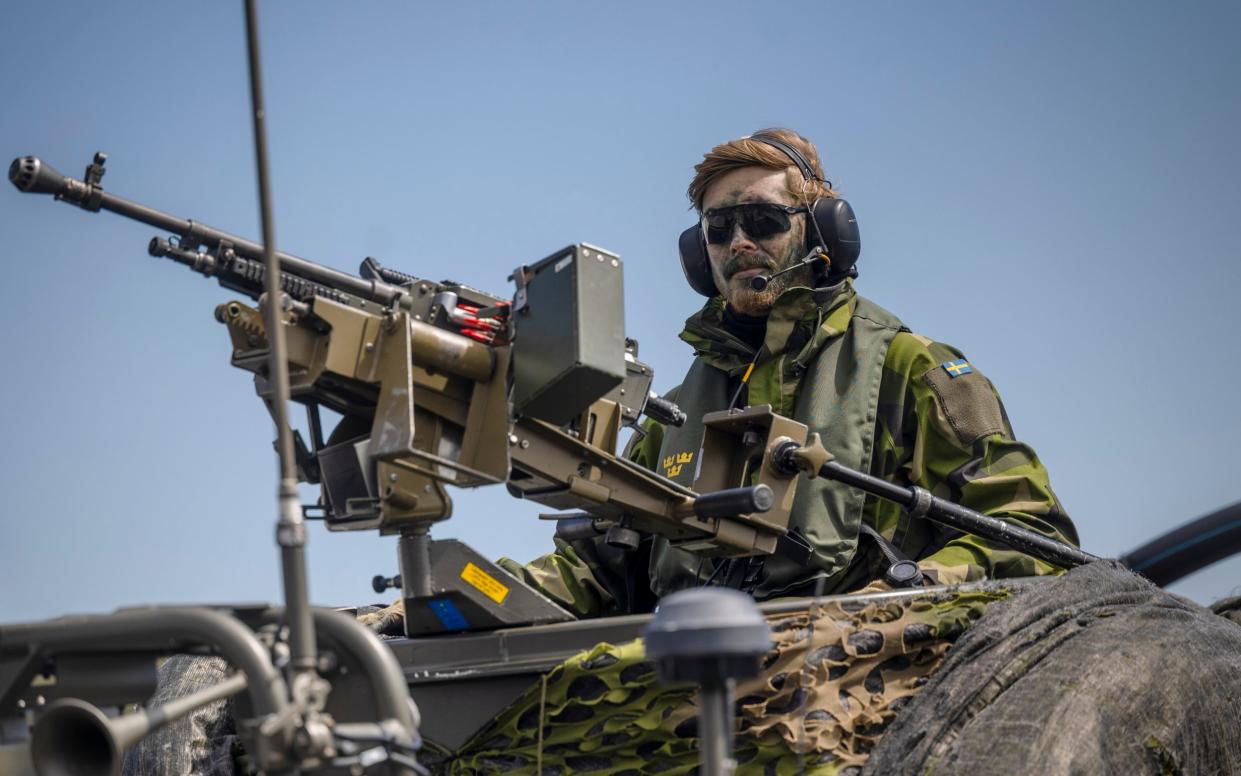Nato needs Sweden’s military build-up after opening 2,000 mile Russian border

Sweden’s most extensive military build-up for decades will significantly strengthen Nato’s eastern flank against Russia when it finally joins the alliance.
Jens Stoltenberg, the Nato secretary-general, said the alliance will soon be “stronger”, after the Hungarian parliament finally approved the accession and Turkey previously dropped its veto.
With more than 120 Leopard 2 main battle tanks, a large air force equipped with domestically produced fighter jets, and a formidable navy, the Swedish armed forces will soon be tasked with defending Nato’s newest border – its 2,000-mile Baltic Sea coastline.
Despite its slightly hippy-ish reputation, Sweden was once one of the most militarised countries in Europe, with hundreds of thousands of conscripted Swedes under arms when the army was at its peak.
But in the 1990s, Stockholm began a series of stinging defence cuts that slashed its military to one of the smallest in Europe, with defence spending falling from over 3 per cent of GDP to around 1 per cent.
“We were banking on a brave new world of no more wars,” said Niklas Granholm, deputy director of the Swedish Defence Research Agency. “The Russians were on their best behaviour, so we concentrated on support and crisis management operations far away.”
Russia’s invasion of Georgia in 2008 drove the first nail into the coffin of the peace-and-love era and made Swedes realise that they better re-arm.
The Russian annexation of Crimea in 2014 and then the 2022 invasion of Ukraine accelerated the process, while also prompting Sweden to apply to join Nato, along with its Nordic neighbour, Finland, after decades of neutrality.
But rebuilding Sweden’s military after decades of neglect would be no easy feat.
In 2013, one of Sweden’s top generals was forced to admit that his forces would only be able to defend part of the country and even then only for around a week.
To reverse the decline, defence spending was first raised to 1.5 per cent of GDP and then to 2 per cent – the Nato minimum requirement and a figure the government predicts it will reach in 2026.
Wary of the growing threat posed by Russia, in 2020 the Swedish government rolled out its ambitious defence bill that hiked defence spending by 40 per cent, allowing it to double the size of its armed forces to 90,000, including regular, conscript and reserve forces. It also added one more mechanised brigade to the army, bringing the total to three. The flow of money has allowed its armed forces to place new orders for new, high-tech equipment, including upgraded Gripen warplanes and submarines.
The 2020 bill also built on a 2017 decision to establish the country’s first new regiment since the Second World War. The new unit now guards the strategically important island of Gotland, which occupies a dominant position more-or-less in the middle of the Baltic Sea.
But while Sweden has undoubtedly been playing catch up, it never lost its significant technological capacity in aeronautics and underwater warfare.
This means its air force now has over 70 Swedish-made-and-designed Gripen multirole combat jets, and is also introducing the first 60 of the latest version of the aircraft, the Gripen E.
Combine Sweden’s air power with that of the other Nordic countries, and there are 200-250 modern and formidable jets patrolling the skies to ward off regular Russian incursions.
On land, its forces are similarly formidable, with the army operating large numbers of sophisticated German-made Leopard 2 main battle tanks – the same type currently spearheading Ukraine’s counter-offensive against Russia.
As well as its fleet of tanks, Sweden’s army can also call on nearly 500 CV90 infantry fighting vehicles even after 50 were sent to Ukraine.
The vehicles, optimised for combat in Swedish forests with rapid-fire Bofors autocannons capable of blasting straight through trees, form the backbone of Sweden’s mechanised infantry units.
And then there are Sweden’s submarines.
“We realised in the Cold War that we have to dedicate a lot of resources and assets to keeping them [Russians] out of our waters,” said Mr Granholm. “The underwater warfare dimension developed quickly and was never disbanded.
“And undersea warfare really came to the fore when we had the Nord Stream sabotage in September. This made us realise that an attack on seabed installations was not just a seminar-room discussion about a possible threat but was something that had actually happened.”
Baltic Sea challenges
The Swedish Navy has five diesel-electric attack submarines now in service, all of which are designed to cope with the operational challenges posed by the shallow waters of the Baltic Sea. It also has two A26 submarines on order.
A new class of vessel, the A26, has a specially designed bow that can carry a detachment of special forces or launch underwater drones.
Despite its naval strength, the Swedish armed forces still face one significant obstacle, said Oscar Jonsson, a researcher at the Swedish Defence University.
“The biggest problem is scale,” he said. “The Swedish armed forces are incredibly high-tech, competent and capable, but as the war [in Ukraine] has shown, anything we thought was sufficient was not even remotely close to being so.
“To drive home this point, when the war started, Ukraine had around 1,200 artillery systems, we had 48, and we’re giving eight of them to Ukraine. Across the board, scale is a problem.”

